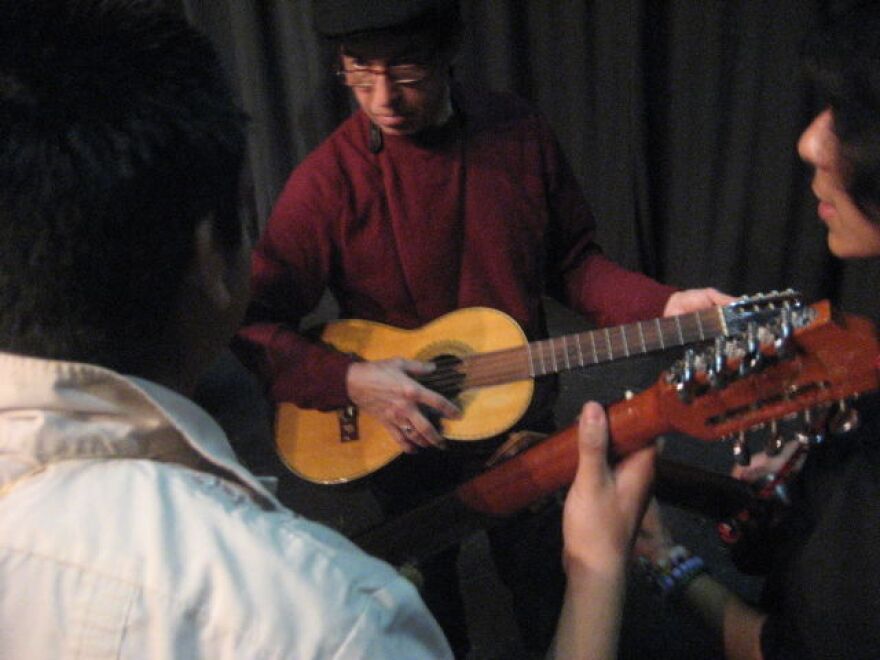Truth matters. Community matters. Your support makes both possible. LAist is one of the few places where news remains independent and free from political and corporate influence. Stand up for truth and for LAist. Make your year-end tax-deductible gift now.
This archival content was originally written for and published on KPCC.org. Keep in mind that links and images may no longer work — and references may be outdated.
High school uses Mexican guitar to motivate students

As Los Angeles Unified School District administrators are set to transfer dozens of campuses this year to non-profit groups that propose new methods to improve learning, the district's Frida Kahlo High School boasts of progress through an innovative East Coast model that got the thumbs up from a Grammy-winning musician this week.
Seventeen-year-old Moises Martinez said he led a gang life in the streets surrounding Kahlo High, near the Harbor and Santa Monica Freeway interchange. "I started gang banging at the age of 12. In a local neighborhood called Primera Flats over here, you can see I’m all tatted out. I got into the gang really deep. I was locked up for four months."
Inside the continuation high school he discovered that the jarana, a ukelele-sized guitar from Mexico, could help him leave that life. "This is a song called 'La Iguana,' we have barely learned it like two months ago and I really like it, I like playing it a lot, so I’m going to play the first part of it."
His tattoos blur as his forearm moves up and down, strumming the guitar's eight strings.
Kahlo High, named after the late Mexican surrealist painter, is run under a so-called interest-based learning model developed by a Rhode Island organization, Big Picture Learning. High school principal Enrique Gonzalez said it tries to find culturally relevant lessons that’ll hook students on learning. "We chose the jarana because it is of the people, it’s call and response from the pueblitos in Veracruz and it’s a genre of music that even in Mexico is not that popular, yet it’s so culturally sensitive to the needs of people that are struggling to survive just as they are in South L.A. or Los Angeles in general."
Gonzalez and the teachers struggle to offer role models the working class students can relate to. They found one in Los Lobos guitarist Louie Perez. In the school’s auditorium, the East L.A. native told nearly 200 students that he grew up in similar circumstances to theirs 40 years ago. "There was a liquor store around the corner, there was a tortilleria around the corner which was kind of cool, and there was a sweatshop, there was a lot of stuff going on and it was kind of a rough neighborhood."
Music helped him survive and thrive. It’s a passion his mother sparked when she took him to the Million Dollar Theater in downtown L.A. when he was eight years old. "There was this mariachi that looked like there were 40 dudes up there, you know what I’m talking about, and they did this big fanfare and the main signer who I think was Antonio Aguilar or Miguel Aceves Mejia, or something like that, came on stage on a big white horse."
Seeing that singer belt out ranchera songs on horseback left a deep impression of the power of music and performance.
During a question-and-answer period, students asked Perez what inspired his song lyrics and how much money he makes. One student wanted to know about a hit song Los Lobos recorded several years before he was born. Perez said they'd heard an older version while growing up. "We always heard 'La Bamba,' you know by Ritchie Valens, when I was a kid we’d listen to 45s, listen to Smokey Robinson, oldies but goodies."
Louie Perez and his bandmates found out the song had centuries-old roots in coastal Mexico – and that the little guitar from Veracruz, the jarana, provided its heartbeat.
He ended the talk by inviting six jarana students, the teacher – a native of Veracruz – to play with him a version of the older and arguably better version of “La Bamba.”
It was just another day of interest-based learning at L.A.’s Frida Kahlo High School.








